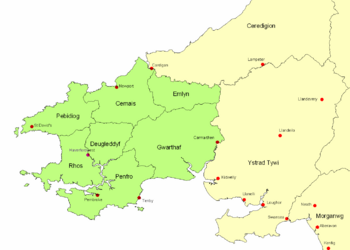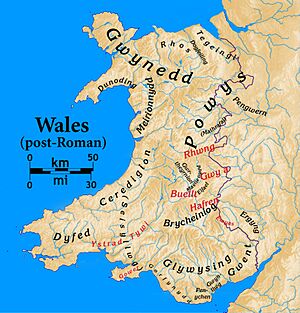Kingdom of Dyfed facts for kids
Quick facts for kids
Kingdom of Dyfed
Teyrnas Dyfed
|
|||||||||
|---|---|---|---|---|---|---|---|---|---|
| c. 410 – 920 | |||||||||

Map showing Dyfed, after the late 7th century, showing its seven cantrefi.
|
|||||||||
| Common languages | Old Welsh, Vulgar Latin, Old Irish | ||||||||
| Government | Monarchy | ||||||||
| Historical era | Middle Ages | ||||||||
|
• Established
|
c. 410 | ||||||||
|
• Disestablished
|
920 | ||||||||
|
|||||||||
The Kingdom of Dyfed was an old Welsh kingdom in southwest Wales. It appeared around the 5th century, after the Roman Empire left Britain. This kingdom was built on the land once held by a tribe called the Demetae. Today, this area is mostly Pembrokeshire and parts of Carmarthenshire.
An old Irish story says that Dyfed was founded by a man named Eochaid. He was forced to cross the Irish Sea in the 5th century. His family then became the kings of Dyfed for many years. Later, between 1067 and 1100, the Normans took over Wales. By 1138, they made Dyfed part of a new area called Pembrokeshire. This new area was named after a Norman castle built there.
Contents
A Look Back: Dyfed's Early Days
Around the year 360, different groups like the Irish, Anglo-Saxons, and Picts began attacking Britain. These attacks continued for a while. The Irish even settled on the Isle of Man. For a short time, Old Irish was spoken in the Dyfed region.
Archaeologists have found twenty stones from this period. These stones have special carvings called ogham inscriptions. One stone, found near Narberth, has writing in both Latin and Irish. It mentions a person named Votecorigas. The Latin part calls him a "protector," which was a title for important people in the late Roman Empire.
Where Was Dyfed Located?
Dyfed likely started in the area between the Teifi, Gwili, and Tywi rivers. This included modern-day Pembrokeshire and the western part of Carmarthenshire. The town of Carmarthen was also part of it.
Over time, Dyfed grew to include at least seven smaller areas called cantrefi. These were Cemais, Deugleddyf, Emlyn, Cantref Gwarthaf, Pebidiog, Penfro, and Rhos. The whole kingdom covered about 2,284 square kilometers (882 square miles).
When Dyfed was strong, it also controlled the Ystrad Tywi (meaning "Valley of the Tywi"). This area included Cydweli (Kidwelly) and Gwyr (Gower). It even bordered another kingdom called Brycheiniog. However, Dyfed lost the Ystrad Tywi region to the kingdom of Ceredigion in the late 7th century.
Religious Life in Dyfed
During a time known as the "Age of the Saints," Dyfed might have had as many as seven bishops. A bishop is a high-ranking church leader. Each bishop had their own area called a parochia. However, by the Middle Ages, the Diocese of St David's became one of only three main church areas in Wales. St. David's covered all of West Wales and part of Mid Wales.
Viking Raids and New Alliances
Between the 8th and 11th centuries, Dyfed faced many attacks during the Viking Age. These raids caused a lot of trouble and made the kingdom unstable. The Vikings even set up their own settlements in southern Dyfed.
By the late 9th century, the rulers of Dyfed became worried about the growing power of the sons of Rhodri the Great, a powerful Welsh king. So, they decided to make friends with Alfred the Great, the King of England. Some historians thought this was a Christian alliance against the "heathen" (non-Christian) Danes. However, it seems Alfred put some pressure on the Welsh rulers. This agreement meant that Welsh rulers accepted that the King of England had some power over them. This idea became very important in the future history of Wales.
The End of Dyfed as a Separate Kingdom
Around 904, Dyfed's ruler, Llywarch ap Hyfaidd, died. His daughter, Elen ferch Llywarch, became his heir. Elen married Hywel Dda, who ruled the nearby kingdom of Seisyllwg. Hywel Dda was also the grandson of Rhodri the Great.
By marrying Elen, Hywel added Dyfed to his lands. He created a much larger kingdom called Deheubarth, which means "the south part." Hywel Dda later conquered other Welsh kingdoms too. After Hywel died in 950, some of these lands returned to their original rulers.
Hywel's grandson, Maredudd ab Owain, tried to bring back his grandfather's large kingdom. But during his rule in the late 10th century, Viking raids became even worse. More Viking settlements appeared, especially in the Penfro area. Other Viking trading posts were set up in places like Haverfordwest, Fishguard, and Caldey Island in Dyfed.
The Vikings attacked the Welsh constantly. In 993, Maredudd had to raise taxes to pay for the release of Welsh people taken hostage by Vikings. In 999, a Viking group attacked St. David's and killed the bishop.
Dyfed remained an important part of Deheubarth until the Norman invasions of Wales between 1068 and 1100. In the Dyfed region, areas like Penfro, Rhos, Cemais, and Pebidiog were taken over by Norman lords. The Normans also started to influence who became bishop of St. David's from 1115 onwards.
The Welsh princes of Deheubarth, and later Llywelyn the Great, fought to get these lands back. This struggle continued until King Edward I of England conquered Wales in 1284. The 1284 Statute of Rhuddlan officially created the English counties of Pembrokeshire and Carmarthenshire out of the land that was once Dyfed.
Uncovering the Past: Archaeology
The Dyfed Archaeological Trust studies the history of this area. They look at archaeological evidence from the time of the Kingdom of Dyfed and other periods. This helps us understand what life was like back then.
Dyfed Today
In 1974, a new administrative area was created in southwest Wales. It was also called Dyfed. This area included Pembrokeshire, Cardiganshire, and Carmarthenshire. However, this administrative area was broken up in 1996.
Even though it's not an official region anymore, the name Dyfed is still used for some special purposes. You might hear it in the names of local groups, like Dyfed–Powys Police or Dyfed Telecom.
See also
- Déisi
- Pwyll Pendefig Dyfed


